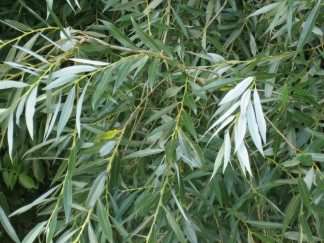
Photo ©2005 MPF
Click photo for a larger image
White Willow - Salix alba
Family - Salicaceae

Photo ©2005 MPF
Click photo for a larger image
White Willow is a fast growing native deciduous tree to the UK, Europe and Western Asia, growing in wet areas, river banks and stream sides up to 10–25m (33–80ft) tall with an irregular crown, greyish brown bark on a fissured trunk to 1m (3ft) in diameter producing a tough wood. Pale coloured lanceolate leaves with a covering of fine silky hairs particularly the underside giving rise to the trees name - White Willow. The leaves are 5–12cm (2–5in) long and 0.5–1.5cm (0.–0.6in) wide. A dioecious species male and female flowers as catkins are found on separate trees in the spring and are pollinated by insects. The male are 4–6cm (1.6–2.4in) long whilst the female are slightly smaller at 3–4cm (1.2–1.6in) but becoming longer as the mature to many small capsules with minute seeds embedded in a white down aiding wind dispersal. Hybridises readily with other Willows especially Crack Willow.
White Willow has many uses, with coppiced trees producing withies for basket–making, charcoal, tannin from the bark was used in the leather industry in the past, and the wood probably more widely known for cricket bats and other uses where a tough, lightweight wood is required. Several cultivars are grown for their colourful leaves and overall silvery–white foliage. Willow foliage is the food source for a number of moth species.
BCP do not advise or recommend that White Willow – Salix alba is eaten or used as an herbal remedy. Willow bark has been used in the past for pain relief as a tincture of crushed bark in ethanol. Salicylic acid the component ingredient of Aspirin was originally derived from Willow bark.
Site design ©1999– Brickfields Country Park - Privacy -